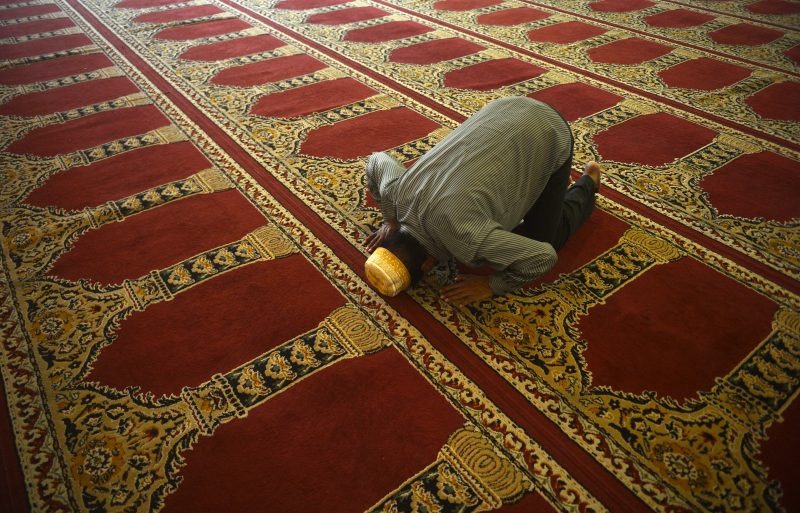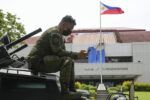Sri Lanka attack mastermind used chatrooms to sway suicide bombers
A man prays at the Dawatagaha Jumma Masjid mosque in Colombo. Sri Lankan Muslim groups say they warned authorities about the increased radicalisation of Easter Sunday attack ringleader Zahran Hashim (ISHARA S. KODIKARA)
Colombo (AFP) – While Sri Lanka Easter suicide attacks mastermind Zahran Hashim used social media to publicly call for the death of non-Muslims, he worked for months in private chatrooms to persuade six young men to sacrifice themselves, Muslim community leaders say.
Christians and foreign tourists were badly hit in the attacks on three churches and three hotels that killed 257 people, but Sri Lanka’s Muslim community has also been badly scarred and has been looking into the backgrounds of Hashim and his jihadist acolytes.
Hashim, who died in an attack on the Shangri-La hotel on April 21, inspired wealthy brothers Ilham Ibrahim and Inshaf Ibrahim to join and bankroll his assault, police and fellow Muslims said.
“We suspect the two brothers used their money from the spice business to finance the bombings,” one police investigator said.
“It seems the indoctrination was via the internet — Facebook and YouTube.”
Neighbours of the Ibrahim brothers said they were secretive but devout Muslims. They were not active members of a congregation, community leaders said.
“We believe Zahran radicalised these people using Facebook,” said R. Abdul Razik, a leader of the moderate Ceylon Thowheed Jama’ath (CTJ) group.
“Especially in the past year, he has been openly calling for the killing of non-Muslims.”
Investigators and community leaders believe the group also used social media private messenges to keep in touch without being noticed by the authorities.
– Warnings failed –
The CTJ and the main body of Islamic clerics, the All Ceylon Jamiyyathul Ulama, had alerted Sri Lanka’s security establishment to Hashim and his acolytes, but said their warnings failed to get serious attention.
The Sri Lankan government has already acknowledged that foreign intelligence warnings about the attacks were not passed on to ministers.
“We asked the intelligence agencies to take down the Facebook page of Zahran because he was polluting the minds of Sri Lankan Muslims,” Razik said.
“We were told it is better to allow him to have the page so that the authorities could keep an eye on what he was doing.”
Another moderate Islamic group, the Sri Lanka Thowheed Jama’ath (SLTJ) said it called a press conference in 2017 to warn authorities about Hashim, but no action was taken.
“Zahran indoctrinated people using social media. He was spewing an IS brand of propaganda that somehow appealed to the bombers,” SLTJ spokesman Thawseef Ahamed told AFP.
A fuller reckoning of those involved in the attacks was only released by authorities this week, revealing at least two sets of brothers.
Ilham Ibrahim died at the Shangri-La hotel while his brother Inshaf Ibrahim bombed the Cinnamon Grand.
Ringleader Hashim also died at the Shangri-la, while his yet-to-be named brother blew himself up when surrounded on April 26 near the eastern coastal town of Kalmunai. He was with three widows of the Easter bombers when police and troops laid siege to the house.
Sixteen people were killed there, including six children, relatives of Hashim, and members of his National Thowheeth Jama’ath (NTJ) movement, which has since been banned.
– Killed children –
The pregnant wife of Ilham Ibrahim, Fathima Ilham, blew herself up when police raided the family home in Colombo hours after the bombings. She also killed her two children and three police officers.
Mohamed Azzam Mubarak Mohamed has been named as the bomber who targeted the Kingsbury hotel in Colombo. His wife is now in police custody.
A fourth hotel was on the bombers’ list. The would-be attacker, Abdul Latheef, failed to set off his explosives. He detonated it a few hours later at a small motel, killing himself and two other people.
Latheef studied aeronautical engineering at Kingston University in Britain and did post-graduate studies in Melbourne, Australia. Australian media said he was under investigation in 2014 by the country’s counter-terrorism unit and may have travelled to Syria.
He also came into contact with Hashim through Facebook posts and Youtube videos.
The men who bombed the three churches have been named as Ahmed Muaz, Mohamed Hasthun and Mohamed Nasser Mohamed Asad. The three were hardly known within their communities, according to Muslim leaders.
Disclaimer: Validity of the above story is for 7 Days from original date of publishing. Source: AFP.


